Reviews
John McTiernan
USA, 1988
Credits
Review by Leo Goldsmith
Posted on 21 July 2009
Source Netflix VOD
Categories Favorites: The Action Movie
I love ya, and a lot of the other guys down here do, too.
—Sergeant Al Powell, LAPD
The Hollywood action movie is almost invariably about an individual action hero, and more often than not this hero is male. This assertion should not strike many as startling, but as our largely male-centric emphasis in this feature thus far reveals, this particular preoccupation with male action, located primarily in the body, would seem to contradict many common claims of critics of mainstream American cinema. Indeed, it is ironic that the heyday of Hollywood action filmmaking would come in the 1980s, the decade following the prominent rise of feminism and its claims of an essential misogyny and voyeurism in Hollywood filmmaking. Either reacting to or coincidental with a discourse about physical or psychological violence against women in American cinema (notably in horror movies of the 70s), Hollywood filmmakers and their audiences turned more attention to violence involving male participants, a phallic face-off of large guns and muscles that largely excludes women.
This is not at all to claim that the action movie is a feminist genre: at best, the exclusion of women represents a limited and still phallocentric preoccupation with masculinity and competition; at worst, it suggests the unimportance of women in a man’s violent world. This is further complicated by the ambivalent place of women in action movies: as the damsel in distress, as the cheerleader on the sidelines, as the pause button-baiting instance of “partial nudity”, as the (very) occasional sidekick. The spectrum pretty much looks like this: Chuck Norris almost never has time for sex; Rambo lands one girlfriend who dies pretty quickly (cue bloody revenge); Schwarzenegger might pal up with one “demure, athletic” woman who gets to kill exactly one bad guy; and, most famously, James Bond enjoys a parade of interchangeable sexual conquests, with some perfunctory lip-service given to the notion of shifting ideas about gender.
Nonetheless, in spite of this shunting of women to the sidelines, the action movie of the 1980s offers some corrective to the notion that classical Hollywood cinema was a device made largely to ogle women’s bodies, to dominate the image of woman through looking. Changing mores and censorship guidelines about the content of film in the 1960s and 1970s not only gave rise to hard and soft pornography and horrific gore, but to a parallel cinema focused primarily on the male body, and particularly what happens to it when it is punched, kicked, shot, or blown up. This focus might itself be a reaction to changing ideas about the primacy of the patriarchy, an indication that total masculine power had been depleted by the 70s, either socially or politically. The humiliation and redemption of the man’s body make for common story-arcs in films like Leone’s spaghetti westerns (specifically the comeback/revenge narratives of Eastwood’s character in A Fistful of Dollars and The Good, the Bad, and the Ugly, and Bronson’s backstory in Once Upon a Time in the West) and especially martial arts and blaxploitation films, genres that have contemporaneously served or spoke for communities of disenfranchised people. In this light, the Hollywood action movie, far from being a univocal and monolithic assertion of a dominant masculinity, actually seems to protest a bit too much, to portray or mythologize an imperiled masculine hero, overdetermined in his fetishized musculature and burdened with something to prove to a society increasingly skeptical of its claims of dominance.
Die Hard, released at the twilight of the 1980s, is frequently cited as the greatest action film of all time - an accolade that this critic (who came of age at the time of its release) has no interest in challenging - precisely because it represents a genre that has fully and self-consciously come back upon itself. The hero of John McTiernan’s film explicitly alludes to many of his generic predecessors - specifically Rambo and Arnold Schwarzenegger, on the one hand; John Wayne, Marshall Dillon, and Roy “Yippee-Kay-Aye” Rogers, on the other - as a way of saying, “I have seen these movies, but I am just a normal guy: a Joe Six-Pack, a Joe the Plumber, a John Q. Public, a John McClane.” As a corrective, a parody, and a critique of the contemporary action movie, Die Hard 1 replaces the rippling heroic figure of the high 1980s with a somewhat slovenly Bruce Willis, whose only slightly above-average fitness is offset by his lack of shoes, whose social class and probable political alignment is telegraphed by his (increasingly grubby) A-shirt, and whose principal weapon is his smart, filthy mouth.
To highlight the place of John McClane in a very real contemporary world, McTiernan’s film introduces him nervously clutching the arm of his airplane seat with white knuckles. This hints at the dangerous notion that the action hero of this film, with a receding hairline and smug look so familiar from TV’s Moonlighting, could be a bit of a pussy.2 Of course, he’s not gay, as his wry reaction (“Fuckin’ California!”) to a kissy male partygoer later suggests. Nor is he asexual, like Chuck Norris: no sooner does John-boy touch down in LA than his head is turned by a succession of California babes (a recurrent theme: even while fighting terrorists, McClane will pause to check out a pin-up or spy on a topless beauty visible from across the street). In fact, our hero is - or was - a family man, now visiting his estranged wife in LA, where she has moved with her kids for a job that pays better than that of her NYPD pater familias. And once John is reunited with his wife, Holly, he finds she has reverted to her maiden name of Genarro, an emasculating gesture to which he can only respond by squabbling. Of course, Bonnie Bedelia’s perfect wifely performance rarely allows her to do more than play the damsel-in-distress role, but even so, McTiernan uses the first few economical and precise scenes of his film to establish his hero as an inattentive father, an unsupportive husband, a deadbeat, a schlub.
But action movies are usually designed to offer their male heroes opportunities for personal redemption, and Die Hard, as a sort of revisionist action movie, does so quite elaborately. For one, its semi-real-time plot, which holes up the hero, his wife, and her colleagues in a Nakatomi Plaza occupied by well-financed European terrorists, gives the film a minute-to-minute immediacy that few films of its genre have. For one, even as we root for McClane in the “action movie” portion of the film, we are also watching a heist film, and we follow with a sort of contingent sympathy the clever scheme of the terrorists as it unfolds mysteriously. While much is made of Willis’s character and its revisionist stance in the action genre, little is made of this element of the film: the way in which the terrorists, led by Alan Rickman’s fey, ruthless, but somehow extremely likeable Hans Gruber, are fun and involving to watch. Lengthy portions of the film are devoted to their brilliant manipulation of the police and the FBI, as well as their greedy, Machiavellian attack on greedy, Machiavellian corporate capitalism, which is partly winning to the audience because it so closely resembles what McClane and McTiernan do throughout the film: that is, to detonate and dismantle a phallic construction in order to satisfy personal imperatives. This is coyly caricatured in the way that Hans dryly rattles off names of incarcerated “comrades” abroad (“Asian Dawn?” “I read about them in Time magazine.”) to the feds to keep them spinning their wheels.
The only reason we don’t ultimately root for the terrorists (as we might if this were fully a heist film) is John McClane, not some dolled-up piece of Euro-trash with a penchant of counting to three and shooting people in the head, but a redblooded, blue-collar American. A terrorizer of terrorists, with New York street smarts and a deft ability (attested to by his wife) to piss people off, McClane is a persistent “monkey in the wrench” throughout the film. He is not content to merely deliver his wisecracks after killing someone (though he does this occasionally: “Thanks for the advice,” etc.), but constantly mocks, cajoles, winds up, and badgers the terrorists throughout, right up to his unbelievably brutal sparring with the flaxen-haired Karl, who is trying to avenge brother’s death. McClane makes up for his lack of martial arts training or Schwarzeneggerian physique with inner-city shit-talking and psychological warfare, taunting Karl with details of his brother’s dying screams (in fact, a convenient lie) as he bashes his opponent’s blonde skull into some metal pipes and strings him up by the neck with a chain. It is as if to say, “This is how we do it in Brooklyn.”
Most importantly, however, Die Hard makes us aware of this sense of indefatigable Americanness through the particular demands the film places on McClane’s imperfect, utilitarian body. With the Twinkee-ful cop-physique of Sergeant Al Powell offered as a kind of LAPD foil, McClane’s somewhat better form is the object of a very palpable disintegration, both through increasing fatigue (which McTiernan elegantly accounts for in the film’s pacing, with well-timed smoke-breaks) and especially in the amount of physical pain the hero endures. He undertakes several grueling fistfights (bookended by those with Karl and his brother), is shot and shot at by terrorists and FBI guys alike, and runs around for the film’s duration in famously action-inappropriate attire. Contrary to 80s convention, Willis’s eventual shirtlessness shows off his burly, but untoned and unwaxed chest, and his lack of shoes places his character in a physically vulnerable position. (“Better than being caught with your pants down,” he later quips, raising with reverse psychology the question of who in fact wears the pants in this film’s system of relationships.) Late in the film, when McClane is prizing bloody shards of glass out of the sole of his foot, the full melodramatic function of his shoelessness becomes apparent, as he wrenchingly delivers his message of regret and reconciliation to his wife.
This is the rehabilitation of the male character we’ve been waiting for, the therapeutic function of the film as male melodrama (delivered, it should be noted, through Al “I shot a kid!” Powell, who will himself receive a sort of second-tier redemption by the film’s end). Through Willis’s monologue, McClane’s vulnerability is communicated verbally and physically (through blood, sweat, tears, and snot, in the filthiest bathroom imaginable), asserting the righteousness of his character, justifying his claim as patriarch and action hero. It is this impassioned, career-making scene that more or less makes the character and the film work—at least as much, I would argue, as the spectacular action set-pieces, many of which are as extravagant and implausible as those in a Norris, Stallone, Schwarzenegger, or James Bond film. Indeed, this has been the problem with the film’s sequels and nearly all of Willis’s subsequent career, which position the actor as a macho hunk involved in increasingly ludicrous escapades (jumping off planes, surfing atop a dump-truck through a water pipeline, and making actors like Damon Wayans, Matthew Perry, and Justin Long seem plausible heroic sidekicks). McClane’s leap from the top of the skyscraper, henceforth the prototype for the display of balls in cinema, is a feat worthy of all 80s beefcakes and Western serial stars that have come before. It is a return to form as well as a revision of it - “It’s Christmas, Theo. It’s the time for miracles!” - but it would make less sense if it weren’t in the service of reifying both the myth of the tough male hero and that of the supportive, sensitive husband.
- Die Hard even partly suggests its agenda as a highly self-conscious action film through its brazenly nonsensical title, one that seems to derive less from the well-worn phrase that “old habits die hard”, and more from the fact that the words “die” and “hard” sound cool together. This is given further substantiation by the series’ subsequently, deliberately terrible sub-titles: Die Harder (which not only makes less sense than the original title, but seems to intentionally highlight its absurdity), With a Vengeance (there’s some vengeance in the film, but it’s the villian’s, and once again John McClane doesn’t die with it, hard or otherwise), Live Free or you know what (something to do with New Hampshire, I’m guessing). ↩
- By this point, Willis was not only familiar for his smart-ass star-turn opposite Cybill Shepherd in that very gender-equitable television series, but also for his singing career and for the help he offered in marketing Seagram’s Golden Wine Cooler to dudes. ↩
More Favorites: The Action Movie
-

First Blood
1982 -
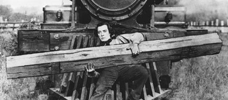
The General
1926 -
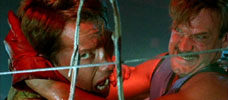
The Running Man
1987 -

Guns
1990 -

Highlander
1986 -
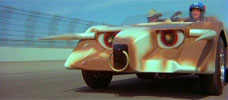
Death Race 2000
1975 -
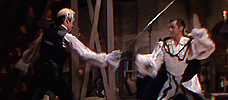
Scaramouche
1952 -
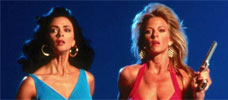
Do or Die
1991 -
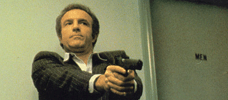
Thief
1981 -
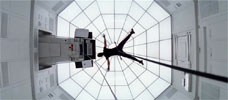
Mission: Impossible
1996 -
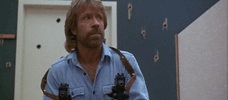
Invasion U.S.A.
1985 -

Rambo: First Blood Part II
1985 -

Bullitt
1968 -
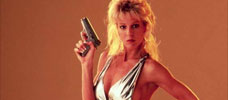
Hard Hunted
1992 -
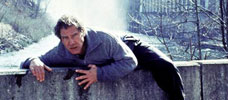
The Fugitive
1993 -
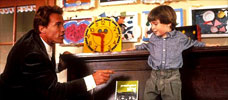
Kindergarten Cop
1990 -
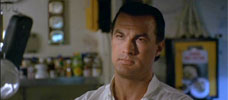
Under Siege
1992 -

Dirty Harry
1971 -
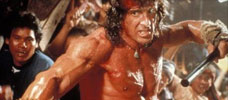
Rambo III
1988 -
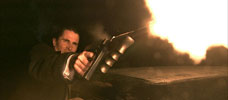
Public Enemies
2009 -
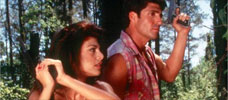
Day of the Warrior
1996 -

The Good, the Bad, the Weird
2008 -
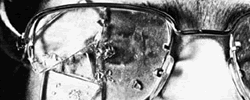
Straw Dogs
1971 -
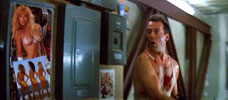
Die Hard
1988 -
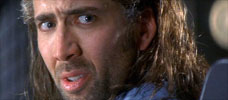
Con Air
1997 -
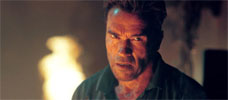
Collateral Damage
2002 -
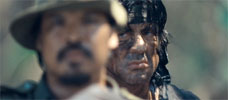
Rambo
2008
We don’t do comments anymore, but you may contact us here or find us on Twitter or Facebook.



